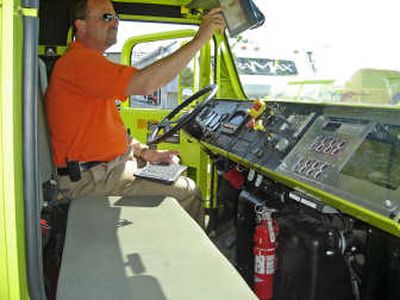Truck hits road without a driver

OSHKOSH, Wis. – Sitting high in the cab of the hulking lime-green TerraMax truck, a driver can be excused for instinctively grabbing the steering wheel.
There’s no need. TerraMax is a self-driving vehicle, a prototype designed to navigate and obey traffic rules, all while the people inside – if there are any – do anything but drive.
During a recent test on property owned by manufacturer Oshkosh Truck Co., TerraMax barreled down a dusty road with its driver seat empty. It stopped at a four-way intersection and waited as staged traffic resolved before obediently lurching on its way.
If the Defense Department gets its way, vehicles like TerraMax – about as long as a typical sport utility vehicle and almost twice as high – could represent the future of transportation for the military’s ground forces.
Consider 80 soldiers driving a convoy of 40 trucks across the Iraqi desert, said Joaquin Salas, spokesman for the Oshkosh, Wis.-based company. If most of those vehicles could drive themselves, the same convoy might manage with just 10 soldiers.
“You’re reducing the number of people susceptible to enemy fire,” said Salas, who served eight years in the U.S. Marine Corps. “It’s simply amazing technology.”
Congress has mandated that one in three ground combat vehicles be self-driving by 2015. The idea is to free personnel for nondriving tasks such as reading maps, scanning for roadside bombs or scouting for the enemy – and to be able to deploy vehicles altogether unoccupied.
The military’s research arm turned to industry and academia to help meet that goal. The Defense Advanced Research Projects Agency, or DARPA, has sponsored a series of contests since 2003 in which prototype vehicles must navigate rough terrain and avoid obstacles.
Oshkosh Truck, a public company that in August projected its 2008 sales would be about $7 billion, is fielding one of 35 teams whose vehicles passed qualifying tests this year. Some teams see the competition as a way to improve automotive technology.
“It’s my view that we’re not just trying to win, but we’re also trying to advance the topic of safer cars,” said Sebastian Thrun, a computer science professor who leads Stanford University’s team. “There are so many other great uses of this technology.”
Thrun called TerraMax “an amazing vehicle, very sturdy,” but noted that the DARPA competition is more about software than hardware. The software that controls TerraMax is Oshkosh’s own, built specifically for the upcoming competition.
It will be years before anyone’s technology for driverless vehicles is put to the test on a real battlefield, but DARPA’s competitions are raising expectations.
Their early results were disappointing. In 2005, only five of 23 vehicles completed the 132-mile course, led by the Stanford team that won the $2 million top prize with its modified Volkswagen Passat station wagon.
This year’s competition is expected to be stiff. Squads from the Massachusetts Institute of Technology and Cornell University are among those invited to participate in an Oct. 26-31 qualifying event in Victorville, Calif., along with industry teams that include employees of Delphi Corp. and Ford Motor Co. The entrants include modified cars, pickups and SUVs.